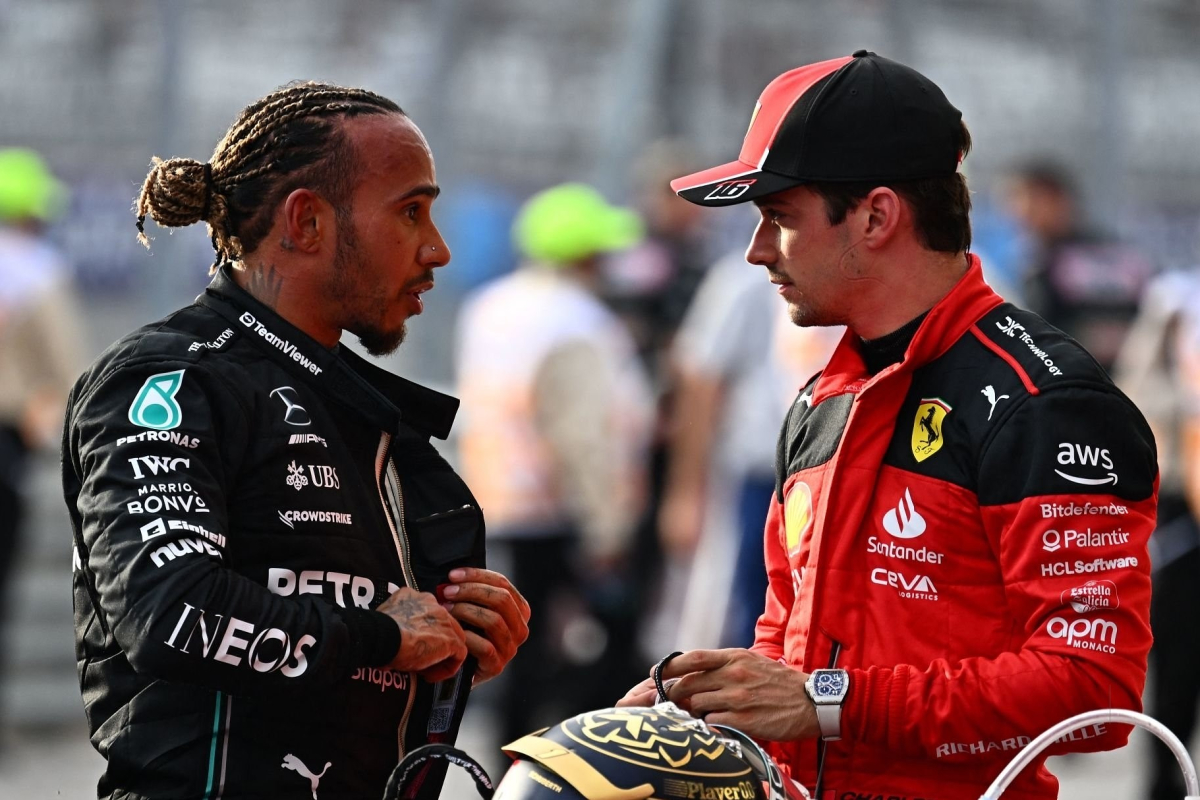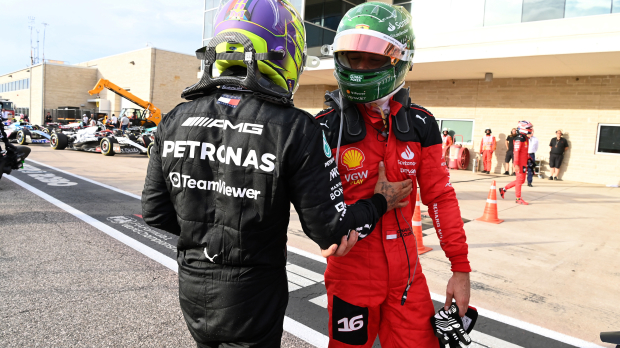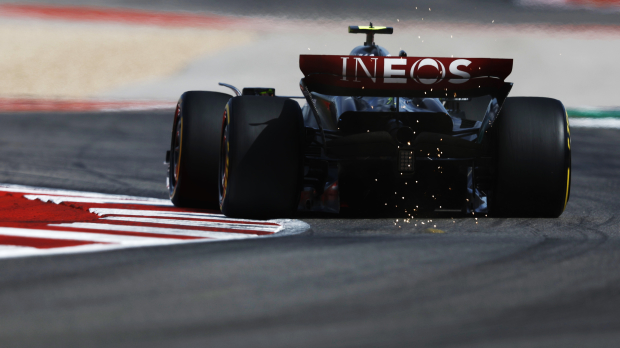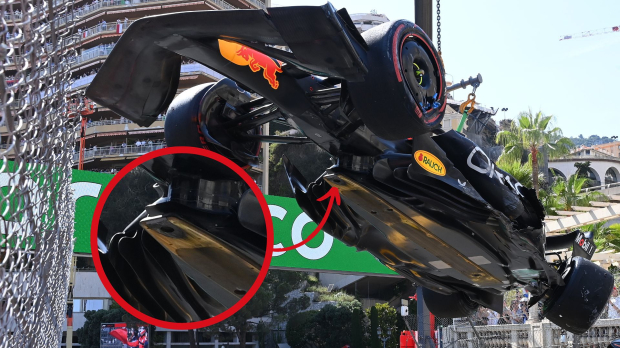
F1 skid blocks explained: Why were Hamilton and Leclerc disqualified from United States GP?
F1 skid blocks explained: Why were Hamilton and Leclerc disqualified from United States GP?

What is the skid block that caused disqualifications for Lewis Hamilton and Charles Leclerc in Austin? Let's find out.
Hamilton and Leclerc were both disqualified from the 2023 United States Grand Prix in Austin, losing their respective P2 and P6 finishes after a post-race random check on four cars.
The check found the skid blocks on the Mercedes and Ferrari to be excessively worn out, meaning their planks did not conform to F1's Technical Regulations.
READ MORE: Hamilton and Leclerc were disqualified in late F1 drama after US Grand Prix


What are skid blocks in F1?
Skid blocks, also known as skid plates or skid pads, are planks placed underneath every F1 car from front to back and are made of glass-reinforced plastic called permaglass.
They were introduced in 1994 as a safety measure following the tragic deaths of Ayrton Senna and Roland Ratzenberger, in order to maintain a minimum ride height and prevent cars from being too low to the ground.
The skid blocks, which were made of wood many years ago, also play a crucial role in protecting the floor of the car when it goes over kerbs or touches the ground at high speed.
What are the skid block rules?
According to F1's technical regulations, the plank must be a centimetre thick. If the plank wears down by more than a millimetre, the car breaches the technical regulations, leading to disqualification.
Article 3.5.9 e) of the 2023 F1 technical regulations states:
"The thickness of the plank assembly measured normal to the lower surface must be 10mm [plus or minus] 0.2mm and must be uniform when new.
“A minimum thickness of 9mm will be accepted due to wear, and conformity to this provision will be checked at the peripheries of the designated holes."

How is plank’s thickness measured?
After a race, officials randomly select cars to carry out checks to ensure they comply with regulations.
This is done by measuring the four 50mm diameter holes and the two forward 80mm diameter holes that are drilled into the car's plank and titanium plates.
The six holes are 10mm deep. If a wear of over 1mm is found during the checks, the driver will be disqualified automatically.
Who was the first to be disqualified for illegal skid block wear?
At the 1994 Belgian Grand Prix, Michael Schumacher became the first driver to break the newly introduced skid block rule.
The German legend's victory in Belgium was short-lived as the skid block on his Benetton was found to have worn down excessively, resulting in his disqualification from the race.
Why do F1 cars spark?
The sparks come from titanium plates attached to the plank. When the car bottoms out, especially on straights when the downforce is strong, these parts hit the ground, creating a bright and fiery spark behind the car, which is a thrilling sight for F1 fans.
READ MORE: What is downforce and why is it important in Formula 1?
Related news

Superstar rapper partners with F1 in surprise venture

Brundle demands drastic F1 change with drivers divided

F1 stars to feature in Netflix LIVE STREAM with brand new Las Vegas tournament

Disney F1 documentary gets official release date
Most read

FIA take action after Verstappen track limits mishap

F1 News Today: FIA make changes as Mercedes receive double penalty and Horner curses bad luck

Stroll issues Alonso Aston Martin contract verdict

Red Bull to replace driver at Abu Dhabi Grand Prix

Horner takes aim at Kravitz with savage jibe at Sky Sports pundit
F1 Standings

Drivers
- Charles Leclerc
- Carlos Sainz
- Lando Norris
- Oscar Piastri
- Pierre Gasly
- Esteban Ocon
- Sergio Pérez
- Max Verstappen
- Alexander Albon
- Logan Sargeant
- Lewis Hamilton
- George Russell
- Nico Hülkenberg
- Kevin Magnussen
- Fernando Alonso
- Lance Stroll
- Valtteri Bottas
- Zhou Guanyu
- Nyck De Vries
- Liam Lawson
- Daniel Ricciardo
- Yuki Tsunoda
Races
-
 Gulf Air Grand Prix of Bahrain 2023
Gulf Air Grand Prix of Bahrain 2023
-
 Saudi Arabian Grand Prix 2023
Saudi Arabian Grand Prix 2023
-
 Grand Prix of Australia 2023
Grand Prix of Australia 2023
-
 Grand Prix of China 2023
Grand Prix of China 2023
-
 Grand Prix of Azerbaijan 2023
Grand Prix of Azerbaijan 2023
-
 Miami Grand Prix 2023
Miami Grand Prix 2023
-
 Qatar Airways Gran Premio Del Made In Italy E Dell'emilia Romagna 2023
Qatar Airways Gran Premio Del Made In Italy E Dell'emilia Romagna 2023
-
 Grand Prix of Monaco 2023
Grand Prix of Monaco 2023
-
 AWS Gran Premio de España 2023
AWS Gran Premio de España 2023
-
 Grand Prix du Canada 2023
Grand Prix du Canada 2023
-
 Grand Prix of Austria 2023
Grand Prix of Austria 2023
-
 Aramco Grand Prix of Great Britain 2023
Aramco Grand Prix of Great Britain 2023
-
 Grand Prix of Hungary 2023
Grand Prix of Hungary 2023
-
 Grand Prix of Belgium 2023
Grand Prix of Belgium 2023
-
 Heineken Dutch Grand Prix 2023
Heineken Dutch Grand Prix 2023
-
 Grand Prix of Italy 2023
Grand Prix of Italy 2023
-
 Grand Prix of Singapore 2023
Grand Prix of Singapore 2023
-
 Grand Prix of Japan 2023
Grand Prix of Japan 2023
-
 Qatar Grand Prix 2023
Qatar Grand Prix 2023
-
 Grand Prix of the United States 2023
Grand Prix of the United States 2023
-
 Gran Premio de la Ciudad de Mexico 2023
Gran Premio de la Ciudad de Mexico 2023
-
 Rolex Grande Prêmio de São Paulo 2023
Rolex Grande Prêmio de São Paulo 2023
-
 Heineken Silver Las Vegas Grand Prix 2023
Heineken Silver Las Vegas Grand Prix 2023
-
 Grand Prix of Abu Dhabi 2023
Grand Prix of Abu Dhabi 2023
About GPFans
GPFans is a multi-platform, multi-language brand dedicated to Formula One coverage. We bring you all the ins and outs of the sport, 24/7, everything from up-to-the-minute news and features to the latest viral stories and clips.We believe that a new generation of exciting, outspoken drivers will make F1 more popular than ever before, and we want to give our users access to as much of their heroes as possible, on and off the track. From Lewis Hamilton to Max Verstappen, Daniel Ricciardo to Sebastian Vettel, we provide in-depth analysis of every every Grand Prix in the season, from Australia to Abu Dhabi.
With Formula One under the new ownership of Liberty Media, how the sport is being covered is evolving, and GPFans will look to be at the heart of this progression into new media, as one of the fastest-growing sites covering the king of motorsports.
Follow us on your favorite social media channel
Corporate & Media
 Innovatieweg 20C
Innovatieweg 20C7007 CD, Doetinchem, Netherlands
+31645516860













 Gulf Air Grand Prix of Bahrain 2023
Gulf Air Grand Prix of Bahrain 2023  Saudi Arabian Grand Prix 2023
Saudi Arabian Grand Prix 2023  Grand Prix of Australia 2023
Grand Prix of Australia 2023  Grand Prix of China 2023
Grand Prix of China 2023  Grand Prix of Azerbaijan 2023
Grand Prix of Azerbaijan 2023  Miami Grand Prix 2023
Miami Grand Prix 2023  Qatar Airways Gran Premio Del Made In Italy E Dell'emilia Romagna 2023
Qatar Airways Gran Premio Del Made In Italy E Dell'emilia Romagna 2023  Grand Prix of Monaco 2023
Grand Prix of Monaco 2023  AWS Gran Premio de España 2023
AWS Gran Premio de España 2023  Grand Prix du Canada 2023
Grand Prix du Canada 2023  Grand Prix of Austria 2023
Grand Prix of Austria 2023  Aramco Grand Prix of Great Britain 2023
Aramco Grand Prix of Great Britain 2023  Grand Prix of Hungary 2023
Grand Prix of Hungary 2023  Grand Prix of Belgium 2023
Grand Prix of Belgium 2023  Heineken Dutch Grand Prix 2023
Heineken Dutch Grand Prix 2023  Grand Prix of Singapore 2023
Grand Prix of Singapore 2023  Grand Prix of Japan 2023
Grand Prix of Japan 2023  Qatar Grand Prix 2023
Qatar Grand Prix 2023  Gran Premio de la Ciudad de Mexico 2023
Gran Premio de la Ciudad de Mexico 2023  Rolex Grande Prêmio de São Paulo 2023
Rolex Grande Prêmio de São Paulo 2023  Grand Prix of Abu Dhabi 2023
Grand Prix of Abu Dhabi 2023